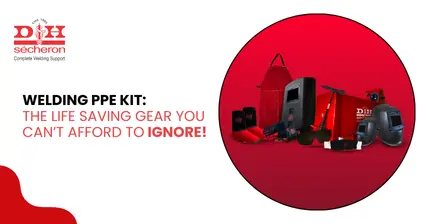Welding, a fabrication process used to fuse two or more metal parts together. This process typically is used on metals and thermoplastics. A welding rod commonly referred to as a welding electrode is what makes or breaks the success of this welding process. Welding electrodes are the medium used to fuse two metals together. These rods are available in different types and their usage depends on the purpose of the machinery. To enable seamless welding results, it is extremely important to choose the right welding electrodes at the initial stage.
There are 3 types of welding rods or welding electrodes produced by welding electrodes manufacturers across the world:
Covered rods
Tubular rods
Bare welding rods
But how does one select a suitable electrode from these for a welding process?
Here are a few steps to consider before you select your welding materials:
Know your base metal’s properties
Your base metal’s composition needs to match or at least closely match the electrode composition for the weld to become successful. Referring to an electrode and metal composition chart for this purpose can be helpful and convenient.
Check the tensile strength
Apart from matching the composition of base metal to the electrode, it is also important to match the minimum tensile strength of the electrode to the tensile strength of the metal. This will avoid cracking or other damage to the metal during the welding process. You can always check the tensile strength of the electrode by referring to the first two digits of the AWS classification printed on it.
Check the welding current
Electrodes often come with the condition of being used only with certain power sources such as AC or DC current. Other electrodes on the other hand can be compatible with both. For medium or deeper penetration of the weld, using electrodes compatible with AC currents is advisable. Electrodes compatible with AC current also produce a soft arc and can be used to weld clean sheet metals.
Know the base metal’s thickness and shape
Determining the thickness of your base metal can help identify which electrode would suit the process. For example, thicker materials require electrodes with high ductility and low hydrogen. On the other hand, thinner welding materials require soft arc electrodes with smaller diameters. This will ensure shallow penetration and help avoid the burning of thinner material.
Determine the welding position
Basically, before choosing an electrode, you need to have a clear idea about your welding procedure. The position of your welding will influence the choice of welding electrode to be used. To find out about each electrode and the position it’s suitable for, refer to the AWS classification chart.
Apart from this, before you begin your welding procedure, make sure your base metal is absolutely clean of dust, rust, grease, and other contaminants. This is an important step to get the perfect desired weld. We hope this article helped you understand the process of welding electrode selection better. If you have more questions, do reach out to us as we’ll be happy to help you.
11 May 2025 | Welding
An In-Depth Exploration of Low-Alloy Steel: Your Comprehensive Guide
11 May 2025 | Welding
Nagpur - Bori - Tuljapur Road MSH-3 in Yavatmal District (Maharashtra)
11 May 2025 | Welding
Guidelines to Understand Gas Welding: Applications, Advantages & Disadvantages
11 May 2025 | Welding
3 Tips for Finding the Best Mild Steel Electrode for Your Application
11 May 2025 | Welding
How to Select the Right Welding Filler Wires for Stainless Steel Welding?
11 May 2025 | Welding
Building the Narendra Modi Stadium with Norma V and Autotherme-1 Electrodes
11 May 2025 | Welding
Low Alloy Steel Welding in a (PEB) Pre Engineered Building Structure
11 May 2025 | Welding
Welding Rods: Different Types and Tips for Properly Storing and Handling
11 May 2025 | Welding
Tips for Flawless Welds with Stainless Steel Electrodes: Pros and Cons
11 May 2025 | Welding
Exploring Applications and Benefits of Stainless Steel Welding Electrodes
11 May 2025 | Welding
Welding Basics: Joining Metals with Heat and Pressure - A Beginners Guide
11 May 2025 | Welding
Distinguishing Low-Alloy Steel from High-Alloy Steel: Understanding the Variations
11 May 2025 | Welding
Hard Facing Wire - Understanding the Process and Achieving Optimal Result
11 May 2025 | Welding
Exploring the Advantages of Stainless Steel Electrodes in Welding Applications
11 May 2025 | Welding
Weathering Steel vs. Traditional Steel: A Comparative Analysis of Performance
11 May 2025 | Welding
Choosing the Right Welding Rod: Why 6013 Electrodes Might Be Your Ideal Option
11 May 2025 | Welding
Why 7018 Electrodes Are Preferred for High-Strength Welds in Pipeline Construction
11 May 2025 | Welding
Filler Wire vs. Stainless Steel Filler Wire: Understanding the Key Differences
11 May 2025 | Welding
Exploring the Impact of Filler Material on Welding Quality and Durability
11 May 2025 | Welding
Choosing the Right Cast Iron Electrode for Different Welding Projects
11 May 2025 | Welding
Top Advantages of Cast Iron Electrodes for Industrial Welding Applications
11 May 2025 | Welding
Key Benefits and Challenges of Using TIG Welding in Industrial Projects
11 May 2025 | Welding
5 Reasons Why 7018 Electrode is the Gold Standard for Welding Professionals
11 May 2025 | Welding
Top 5 Advantages of Flux Cored Arc Welding for Heavy-Duty Applications.png)
11 May 2025 | Welding
Lotherme-601: A Game-Changer for Restoring Shoulder Pins in Heavy Machinery
11 May 2025 | Welding
How D&H Sécheron Helped Repair a Rotary Kiln’s Cooler Section with LoTherme 352
11 May 2025 | Welding
Piston Repair for Mining Industry: Cost-Effective Solutions with LoTherme 468.webp)





.jpg)








































.jpg)
.jpg)

.jpg)

.jpg)





.jpg)
.jpg)
.jpg)



.webp)
.jpg)
.jpg)
.webp)
.jpg)






















.png)



.webp)

.webp)
.webp)



